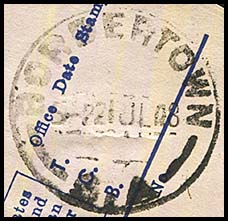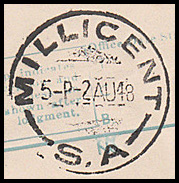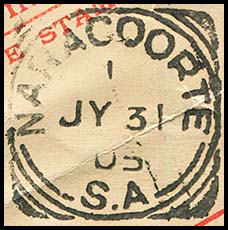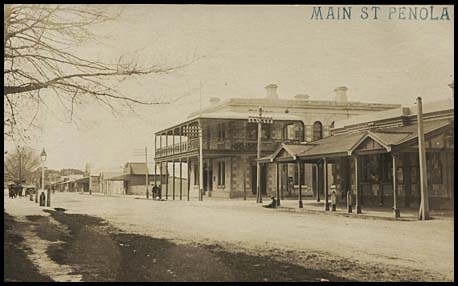Telegraph offices in the Border Town - Mount Gambier region to Victoria.
- Home, index, site details
- Australia 1901-1988
- New South Wales
- Overview of NSW
- Telegraph lines
- Telegraph Offices
- Date stamps
- Forms
- Envelopes
- Rates
- Stamps
- Queensland
- Overview of Qld
- Telegraph lines
- Telegraph offices
- Date stamps
- Forms
- Envelopes
- Rates
- Stamps
- South Australia
- Overview of SA
- Telegraph lines
- Telegraph Offices
- Date stamps
- Forms
- Envelopes
- Rates
- Stamps
- Tasmania
- Overview of Tasmania
- General developments
- Reports
- Organisation
- Telegraph lines
- Telegraph Offices
- Date stamps
- Railway lines
- Forms
- Envelopes
- Rates
- Stamps
- Overview of Tasmania
- Victoria
- Overview of Vic.
- Telegraph lines
- Telegraph offices
- Date stamps
- Forms
- Envelopes
- Rates
- Stamps
- Ephemera
- Western Australia
- Overview of WA
- Telegraph lines
- Telegraph Offices
- Date stamps
- Forms
- Envelopes
- Rates
- Stamps
| Beachport | Border Town | Guichen Bay | Kingston | Lucindale | Millicent |
| Mount Gambier | Naracoorte | Penola |
|
On 5 March 1879, the South Australian Register reported that "the want of the opening of the telegraph line is very much felt. The line is finished but there is no sign of the arrival of an operator yet". The Telegraph Office was opened on 23 May 1879. |
| Border Town.
In May 1877, it had been reported that "The Border Town folks are again moving in the matter of their long delayed railway and telegraph. At a meeting held the other day, resolutions were carried in favor of pressing the claims of the district on the Government". In the finalisation of the Estimates in the House on 1 November 1878, £200 was passed for the Border Town Post and Telegraph Office. The telegraph connection to Border Town was completed on 18 November 1879. The first telegram was sent on that day from Thomas Addison, Chairman Tatiara District Council to Mr. Henning MP and Mr. A. Hardy, M.P.:
It had been announced in the South Austraian Advertiser (2 May) that the building of the Post and Telegraph Offices had been completed in May 1879. Records show that both Border Town and Bordertown were used as the name for this place. From 5 April 1979, the official name was Bordertown. In August 1909, the floods were so bad that the Postmaster was imprisoned in the Post and Telegraph office and telegraphed the Adelaide office to say that he could not get out to read the rain gauge because of the water. In a non-telegraphic observation, Australia's former Prime Minister Bob Hawke was born in Border Town in 1929. |
||
 Bordertown Post and Telegraph Office about 1914. |
 |
|
Size: |
Diameter: 28 mm. Used on AW-DO-10 (46). |
|
| Guichen Bay (Robe).
The Telegraph Office opened on 21 July 1858 as Guichen Bay. The name changed to Robe in 1866. The Post Office had opened in December 1846 but changed its name to Robe in June 1847. Guichen Bay was the oldest port of that part of the South Australian coast and it had been the main outlet for the wool from the Tatiara and Mosquito Plains (Narracoorte) regions to the east. By the 1870s, the trade moved to Port MacDonnell in the east and Lacepede Bay (Kingston) in the west (which also became the terminus of the railway from Narracoorte). |
 Robe Post & Telegraph Office about 1950. |
The people of Guichen Bay were very pleased to have the inter-colonal telegraph line passing through their town. In an article on Guichen Bay, the South Australian Advertiser of 22 February 1859 described the town as "containing a Court House and Police Station, a Post Office, a Station of the Intercolonial Telegraph, a Roman Catholic Chapel, attended periodically by the Rev. Mr. Woods of Penola, an Independent Chapel, also attended from Penola and the residents are now about to commence the erection of a Church of England". In July 1860, the Post-Office was transferred from the Court House to the Telegraph Station and was under the management of the Stationmaster. The Post Office had previously been held by the Clerk of the Local Court and so the change was regarded as being "one of manifest advantage to the public". "The new Telegraph and Post Office are finished and
the work does great credit to the contractors Messrs. Savage & Pearce. The new office will be a very great improvement on the old pigeon-hole wherein a person could scarcely turn". (South Australian Weekly Chronicle 25 October 1860). In October 1861, £200 was allocated in the Estimates for additions to the Telegraph Office at Guichen Bay. The extensions to the Telegraph and Post Office - being a very large room - were completed in October 1862. In 1862, the following report was filed:
On 20 August 1866, the Telegraph and Post Master - Mr. Edward Squire - was transferred to Wentworth after 7 years at Robe. The Chief Line Inspector for the Telegraph Department became involved in an extraordinary demonstration of a snake bite antidote while visiting Guichen Bay in 1861 (Adelaide Observer 16 March 1861). |
|
|
The Telegraph Office opened as Kingston on 2 October 1867. On 16 April 1864, the Adelaide Observer reported that "Some dissatisfaction is felt at the non-acknowledgment of a memorial to the Governor praying for the establishment of a telegraphic station which was forwarded from the Bay to head-quarters some time ago". Finally, in the 1866 Estimates, £2,000 was allocated for a Telegraph Station and Post Office. The new building was soon regarded as being a "superior Post & Telegraph Office".On 1 October 1868, the Post Office was relocated to the Telegraph Office. In addition to the features noted above (see Guichen Bay), Kingston also attracted the interests of Victorians as Horsham was only 60 miles to the east and the area around Kingston was freer of mallee scrub and more resembled the Wimmera lands. |
||
No special date stamp was issued to the Office for use with telegraphic matters. Instead the usual postal date stam was used for telegrams.
|
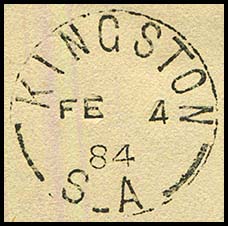 4 February 1884. Used on SC-DO-6Ac |
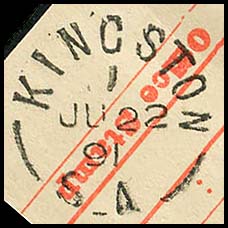 22 July 1891. Used on SC-DO-7A. |
 |
||
|
A Telegraph Office was opened on 13 April 1878 and the usual congratulatory messages sent. It was, at that stage, considered by some as being an intermediate station on a Kingston to Narracoorte telegraph line to Victoria. Lucindale was called Baker's Range until June 1877. |
| Millicent.
The Telegraph Office opened on 7 June 1876. |
Used on AW-DO-10F (45) . |
| Mount Gambier.
The Telegraph Office opened in 1858. The Post Office had opened on 22 September 1846. The early mails were carried and delivered by the police.
|
 Mount Gambier Telegraph Office in 1860. Mount Gambier Telegraph Office in 1860.Source: Museum Victoria B27047. |
|
The South Australian Register of 29 July 1857 made a surprising announvement:
An amalgamation of the Post and Telegraph Offices at Mount Gambier was announced in late 1860. A number of residents disapproved as shown in the following Letter to the Editor of the South Australian Register of 21 November 1860:
|
||
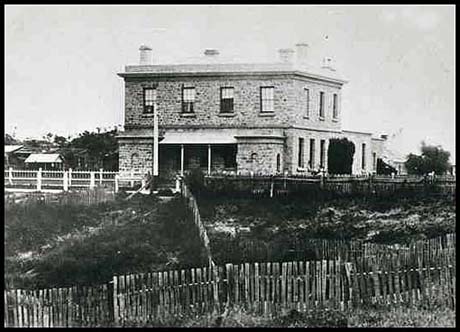 Mount Gambier Telegraph Station in 1870. Mount Gambier Telegraph Station in 1870. |
 Mount Gambier in 1880. Mount Gambier in 1880.Source: Museum Victoria B21766-41. |
|
(Right): The garden reserve in front of the Mount Gambier Post and Telegraph Office. The stairs leading down can be seen in the centre. It is uncertain - but suspected - that it was in this garden that the sparrows were released by Mr Stapleton on 13 May 1868. |
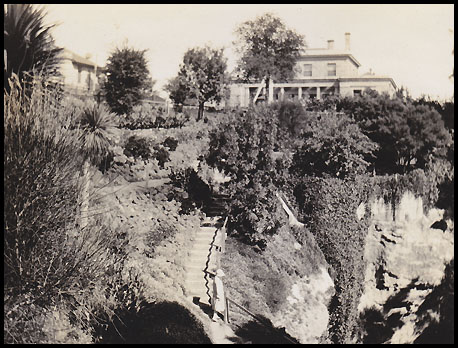 |
|
In the Estimates for the half-year to December 1865, £400 was allocated for outbuildings and fencing. It was notified that, as from 3 August 1867, the Post Office business would be conducted in the old telegraph building. (Border Watch). However, on 4 August 1877, the Minister of Agriculture stated in the House that "nothing would be gained by amalgamating the Post and Telegraph offices at Mount Gambier". In the new Australian Parliament, on 30 October 1902, the question was asked that, when the new telegraph rates came into force, would the name "Mount Gambier" be counted as one word or two. The Chief Secretary did not know the answer but said the problem would be overcome by simply calling it "Gambier". A more detailed history of the Mount Gambier Telegraph Office is contained elsewhere. 400 was allocated to the Mt. Gambier Telegraph Station for the call signal. |
||
| A steel date stamp was issued to the Mount Gambier Telegraph Office for use with telegraphic matters (SC1-TO). The inscription at the top is: T.O. MOUNT GAMBIER. See also SA datestamps.
Although Mount Gambier was allocated a post code in September 1967, the code of 5291 does not appear on this date stamp. Possibly the date stamp was made earlier but there is no record of earlier use. |
 19 January 1970. Used on Confirmatory Delivery envelope AA-EC-3Ae (68). |
|
| The only slogan postmark used at Mount Gambier was that for SEND A TELEGRAM. | |
 |
Used 14 January 1939.
Die 3A: A over EG. |
| Naracoorte.
The Telegraph Office opened in July 1863 as Kincraig. Until 1861, it had been known as Mosquito Plains. The town was spelt as either Narracoorte or Naracoorte.
The Border Watch of 22 November 1882 noted
The editor added - I need only say "That's so." |
|
|
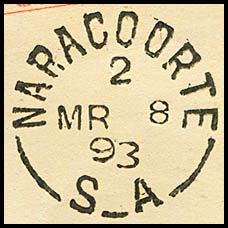 Narracoorte unframed date stamp. Narracoorte unframed date stamp.8 March 1893. Diameter:
|
A squared circle date stamp was also used on telegrams received at Naracoorte.
|
As shown by following this hyperlink, the place name still has the RR in the spelling. |
|
The Telegraph Office opened on 21 July 1858 as Guichen Bay and changed its name to Robe in 1866. Mr. J. A. G. Little, who had been the Telegraph Master at Robe, was selected in June 1871 for the important position of Telegraph Master at Port Darwin. |
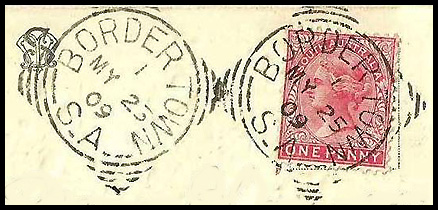 Bordertown squared circle used on postcard but was also used on telegrams.
Bordertown squared circle used on postcard but was also used on telegrams.